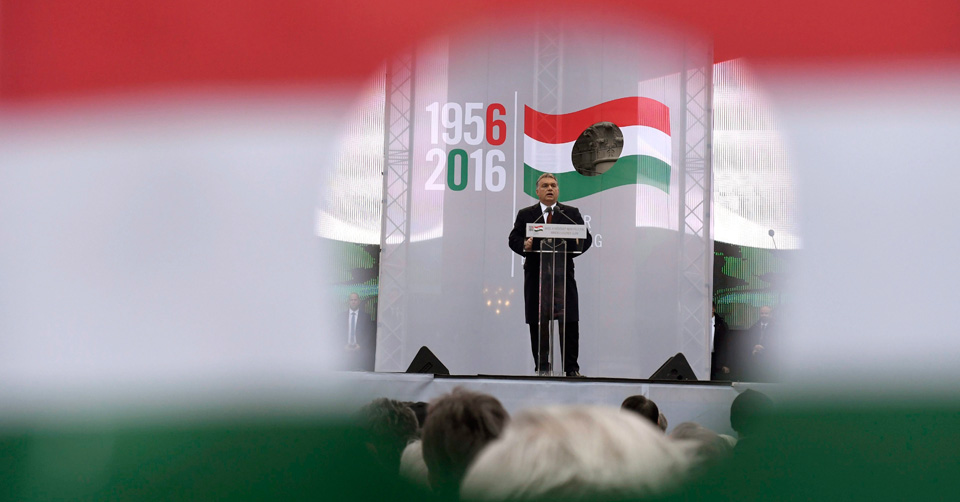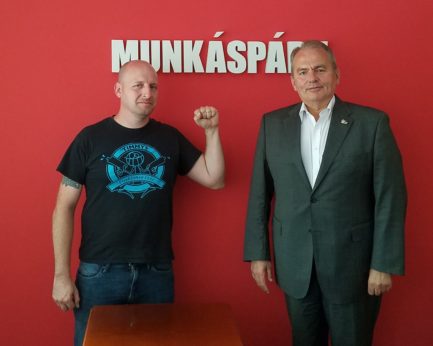
In mid-July, I found myself in a part of Budapest I had never visited, Újpest (“New Pest”), a village on the outskirts of Budapest until the late 1950s. During that time, the government led by János Kádár began erecting massive apartment blocks as a means to eradicate homelessness in the city of Budapest. Those towers, made of pure concrete panels, were never meant to last more than 50 years.
Today, Hungary’s governing right-wing and neoliberal FIDESZ party has no interest in replacing or modernizing those buildings. It is fitting then that Újpest is where most of, if not all, the workers of Budapest live and raise their families, and where the Munkáspárt (Hungarian Workers Party) recently moved its headquarters. The party was founded after the Hungarian Socialist Workers Party, which had governed Hungary from 1956, split in 1989 after falling from power.
A little historical background is perhaps needed. Hungarians recognize three different periods of workers’ rule in their history: The Hungarian Soviet Republic, which existed for 133 days in 1919; The hardline era (1949-1956) under Mátyás Rákosi, an authoritarian and close friend of Joseph Stalin; and the socialist period (1956-1989) under former WWII partisan János Kádár, who became communist leader in the wake of the 1956 Hungarian Revolution. Over those more than 30 years, the living standards of Hungary soared while inequality crashed and burned.

If you ever have the chance to speak with a Hungarian, you’ll likely find that their dislike of the era of communist rule is not due to their opposition to socialism, but rather because of the loss of national autonomy that was experienced under Soviet domination.
As I and my partner in travels, Hellenbort Richard, walked from the tram station towards the Munkáspárt headquarters, I couldn’t help but notice that right-wing political parties had also set up offices in the village. The FIDESZ (right wing moderate/conservative) and JOBBIK (extreme right) parties were the most notable.
Outside the building we were met by the Workers Party chairman, Thürmer Gyula, and Central Committee member Marina Pilajeva. Pilajeva and I had met three years prior at the party’s former headquarters in Budapest’s 8th District.
This new site was quite the upgrade in modern style and much more inviting. The memories of past socialist accomplishments were proudly displayed along the walls, but the focus today was discussing 21st century socialism, the Workers Party, and its path forward.
With the complicated political stage back home in the U.S., I couldn’t help but ask Thürmer why he thought new extreme political parties had such a draw on voters.
“Perhaps this is the same in most capitalist countries. The Hungarian youth is disorientated to a very great degree. Get the money. Spend the money. But to deal with policy, they are looking for some values, and they try to find these values among the radical right organizations. They have come to our party in recent years. Why? Because they have come to understand that if I am born into a poor family, I have all the possibility to remain poor all my life.”
I told Thürmer of how socialism was gaining in appeal among younger American voters, and asked whether there had been interest in organizing the youth into Munkáspárt.
He said, “At first, we only had comrades as members who were old enough to be on a pension. They had more time. They had more possibilities and more courage and political experience. We started at the bottom with the older generation.”
But that situation is beginning to turn around. The membership now, he said, is mostly people who are 40-something. These are people who were born under the old socialist system and still remember it. “They say ‘we understand that our parents lived better than we do now.’ Some of them say that ‘we understand now that we will never live as well as our parents did live.’”
Thinking back to when I first met Pilajeva, I remember she explained that Munkáspárt was a grassroots organization. Transitioning from a ruling party to a grassroots party has proven successful for some communist political organizations after the collapse of the socialist governments of eastern Europe: the Communist Party of Moldova, Die Linke (The Left) in Germany, and the Communist Party of Bohemia and Moravia in the Czech Republic.
So, I asked Thürmer, how does a former ruling party maintain relevance after it is no longer in power?
“We do not receive any financial support from the state. The younger members pay their dues electronically, but a vast majority of members pay their monthly fees in cash. They are not accustomed to the electronic system. Also, a majority of parties recommend that we do not use electronic methods, because capitalists control our money.”
He says Munkáspárt also concentrates on special elections between the major national elections. “Of course, it is very difficult to win an election when you do not live in a village; but we show up, we collect signatures, we give our propaganda, and they get to know us.”
On-the-ground contact is key. “We meet the people where they live: in the markets and in the streets. One of the first laws the capitalist government passed forbids us to organize in the workplace. For decades in the socialist system, organizing for the party was only in the workplace.”
For Munkáspárt members, practical political work is the focus. “We believe that the party should be like an army,” according to Thürmer. “If the soldiers are not given concrete work, they will lose discipline. On the internet, everyone is a great communist revolutionary. However, taking the time to do the real work is a sacrifice.”
My eyes looked down at the table and saw one of the new literature pieces of the Workers Party: Harvesting combines moving in formation, exposing the Munkáspárt emblem as they reaped their crops—quite a stunning image paying respect to agricultural workers. It reminded me of our own political challenges in the U.S.
During the early 1990s it was common for the newly-elected governments of eastern Europe to pass laws making it harder—impossible even—for the communist parties that found themselves now in the opposition to participate. Those laws were passed to keep socialist and communist parties from ever again gaining a political majority in government once people realized the difficult truths of living in a market economy. Is that still the case now?
Thürmer says that his party still faces hurdles. “To be allowed to take part in the Hungarian parliament, a party had previously needed 4 percent of the national vote. When we (Munkáspárt) got close to this amount, the government then raised the bar to 5 percent.”
Labels also present a challenge in post-socialist Hungary, but Munkáspárt persists.
“It is not legal to use the name ‘Communist’ in the name of the party. Our hearts are Communist, but the name itself is less important. Naturally, we would like to use the red star and such, but you can exist without it.”
The promise of higher living standards under liberal policies has fallen flat and created a major population crisis for Hungary. Skilled workers are leaving the country in droves, especially in rural areas.
Many employers in the smaller cities and villages are demanding twelve-hour shifts from the remaining workers as the labor pool has critically shrunk. The housing market is backed by the Swiss franc, the most valuable currency in the world, causing home ownership to be nearly impossible. And a nationalistic rebuke of the euro has caused the national currency (the forint) to decline in value.
While discussing how public sentiment seems to be tiring of capitalism, Mr. Thürmer made a statement that struck me to the core.
“The future of capitalism in Hungary will not be decided in Hungary,” he says. “We have a saying: ‘when it rains in Germany, we open our umbrellas in Hungary.’”

Hungary, a nation of ten million, has been reliant on the larger economies of other nations since the collapse of the Austro-Hungarian Empire at the end of World War I. In 1919, the budding Hungarian Soviet Republic depended on support from Russia’s Bolsheviks. In the interwar period, it was Germany’s support that was needed.
After WWII, of course, Hungary was reliant on the Soviet Union and trade with the other socialist countries of eastern Europe. After 1989, all hopes were put into the European Union—essentially Germany, England, and France.
In other respects, though, the workers’ struggle in Hungary is similar to that in the USA, and both nations have experienced a tremendous backsliding of workers’ rights since the end of the Cold War.
I recognized, at that moment, how privileged I was to sit, drink coffee, and discuss political activism with comrades 5,100 miles away from home. After a few photos with Comrades Thürmer and Pilajeva, it was time to head out.
As a parting gift, Thürmer handed us autographed copies of his most recent published work. My abilities at speaking Magyar (Hungarian) are laughable at best, but I understood when Richard explained how much the book meant to us.
On the tram home, Richard, who has voted for the extreme right-wing party JOBBIK in the past and also (seemingly paradoxically) spoken of the superiority of socialism, held up the book with a serious face, turned to me, and said:
“I am going to read this book. I like what Thürmer Gyula had to say. Plus, would Orbán Viktor [current prime minister and head of FIDESZ] take the time to speak with us? No, this guy has proven that they (Munkáspárt) are the party of workers.”
Al Neal contributed to this article.










